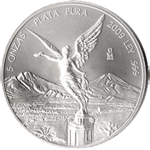The demand for silver can be categorized into two primary uses: As an Investment or for Industrial use.
Investment demand is sourced from individual and institutional investors who choose to add silver to their investment portfolio, which can be done in a variety of ways:
- Bullion: Silver in the form of bars that are at least 99.9 % pure.

- Official Coins: Silver coins issued by a government mint.
- Medallions (Rounds): A round piece of silver resembling a coin but not considered legal tender. Medallions may be issued by governments or private mints.
- Certificates or Storage Accounts: Silver is kept in storage but the investor can take possession within a few days if desired.
- Accumulation Plans: This approach enables investors to accumulate silver on an average basis, similar to dollar cost averaging. The investor does not own the physical silver.
- Futures and/or Forward Contracts: An agreement made on an exchange to take or make delivery of silver at a set date in the future.
- Options: The right, but not the obligation, to buy or sell silver or a financial security linked to silver on a specified date in the future.
- Exchange Traded Fund ("ETF"): A basket of equities linked to silver, i.e. the physical metal, producers, refiners, etc. ETFs are traded on exchanges throughout the trading day.
- Mutual Funds: An open-ended fund that holds a basket of silver-related equities that are priced once daily.
The industrial demand for silver comes from applications in electronics, medicine, jewelry, silverware and more:






- Silver Jewelry: This popular alloy is ideal for silver earrings, silver bracelets and silver necklaces because its durability ensures pieces will stay securely fastened when worn.
- Décor and Tableware: Silver tableware is beautiful, resists tarnish and is a traditional decoration in homes around the world. Copper is mixed with silver to strengthen it for use as cutlery, bowls and decorative items.
- Insulation and Energy Reduction: Silver has a key behind-the-scenes role in the production of two highly versatile chemical compounds that are increasingly being used in thermal and electrical insulation. More than 700 tonnes of silver are used each year to produce ethylene oxide and formaldehyde, both of which are essential to the plastics industry.
- Alternative Energy: Silver paste is used in 90% of all crystalline silicon photovoltaic cells, which are the most common type of solar cell. These cells are currently being tested for large- and small-scale electricity production around the world.
- Fine Photography: Silver-based technology is essential in many fields. It is not only extremely accurate, but also cost effective, making it a natural choice for medical X-Ray technicians -- especially in developing countries - and those in the motion picture industry.
- Automotive Industry: Over 36 million ounces of silver are used annually in automobiles. Basic functions such as starting the engine, opening power windows, adjusting power seats and closing a power trunk are all activated using a silver membrane switch.
- Water Purification: Silver prevents bacteria and algae from building up in their filters so that they can do their job to rid drinking water of bacteria, chlorine, trihalomethanes, lead, particulates and odor.
- Windows and Glass: Invisible silver is the transparent coating of silver that gives thermal windows their ability to reflect hot summer sun outward and keep internal heat inward.
- Anti-Bacterial: Silver interrupts the bacteria cell's ability to form the chemical bonds essential to its survival. These bonds produce the cell's physical structure so when bacteria meets silver it literally falls apart.
- Catalysts: A substance that increases the rate of a chemical reaction, without being consumed or produced by the reaction, is known as a catalyst. Silver catalyzes the oxidation of an alcohol into an aldehyde called formaldehyde, which is one of the most important industrial and research chemicals.
- Brazing and Soldering: Silver (hard) Soldering or Brazing is a very versatile means of making joints by using a fusible alloy as a filler material between similar or dissimilar parent materials.
- Bearings: Silver bearings are an essential component in many types of engines. With their high temperatures and continuous functioning, engines require a stronger type of bearing than other machinery. When steel ball bearings are electroplated with silver, they become stronger than any other type of bearing.
- Batteries: Silver cell batteries have power-to-weight ratios that outweigh their competitors. Thus, many current rechargeable and disposable batteries are manufactured with silver alloys as their negative side or cathode.
- Electronics: Almost all electronics are configured with silver. Its excellent electrical conductivity makes it a natural choice for everything from printed circuit boards to switches and TV screens.
The total world demand for silver in 2012 was 1,048.3 million ounces. Industrial applications used 465.9 million ounces of silver, 185.6 million ounces was consumed in the jewelry market, 44.9 million ounces was used in the silverware market and over 92.6 million ounces of silver was used in coins and medals.
Source:
The Silver Institute: www.silverinstitute.org
Mining Markets Magazine: http://www.miningmarkets.ca
The Northern Miner: http://www.northernminer.com
SilverStrategies.com: www.silverstrategies.com

